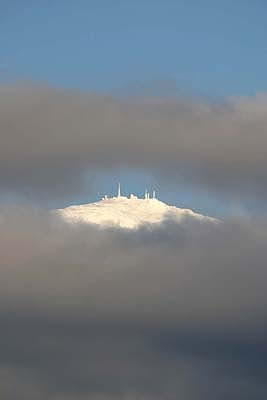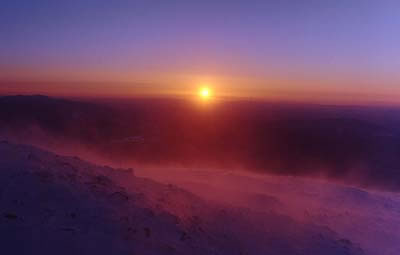|
Geography Worst Weather, Great
Spirit text and photos copyright © 2006 by Mike Colclough, all rights reserved. Excerpted from the introduction of a longer story.
If there is any place that can give even the most artistically-minded spiritualist an interest in science, and reduce the most hard-hearted scientist to tears at the sight of a sunset or a starry night, then New Hampshire's Mount Washington is it. The mountain has long fascinated me for its diverse combination of science and spirituality. If Mount Washington were a person, it would likely be a hero of society, an athlete and a gentleman. As a great athlete, it plays as rough as them all, teaching the myriad small climbers and weather observers a little respect, and always winning the game. Even those who've climbed Mount Everest have had difficulties on Mount Washington. As a gentleman, it's dressed up in formalwear and creates a romantic atmosphere that the world's greatest lovers could only dream of having as a setting for a proposal. With its moods, the mountain makes music as great as the finest orchestra. In one moment it's producing an ear-splitting crescendo, sounding all instruments as it lashes a human with a fit of swirling snow. In the next, it's doing a skillful violin solo as it makes the same person nearly break down in tears at the sight of a beautiful aurora borealis in totally calm winds. Ever since scientists at the Mount Washington Observatory began taking climatic records at the 6,288-foot summit in 1932, the location has earned its reputation for having "The World's Worst Weather." On April 12, 1934, The Observatory recorded a wind speed of 231 miles per hour. It is a world record that still stands today. In the decades since, scientists have successfully proven the mountain to have the most unpredictable-and often deadly-combination of moisture, high wind, and low temperatures anywhere on earth. Over 130 people have perished in it. For all the "worst weather" it has, the mountain is home to such incredible displays of natural phenomena as "green flash sunsets," the northern lights, and views from above the cloud level as though from an airliner. There are mornings when the rising sun glints off of Portland Harbor 65 miles away and afternoons when it sets (with a quick flash of green light) behind the mountains of New York State. Over the decades U.S. Presidents, businessmen, senators and other dignitaries have made the trek to the top to see science, a show of nature, or both. When P.T. Barnum of the Barnum and Bailey Circus saw one of the mountain's "moments of manners" he called it "the Second Greatest Show on Earth." Perhaps the Native Americans called it best: "Place of the Great Spirit." They believed it was the dwelling place of the Great Spirit, and refused to climb it until a white man (Darby Field) paid them to be his guides. Even today, the scientists who work at the top of the mountain refer to (but do not talk about) "The Presence." On a winter night shift, when the weather observer is the only one awake, it's normal for that person to hear the sounds of the wind howling and the steel-reinforced concrete building making loud cracks as it contracts. Those are explainable noises. There have been others, they say, that they cannot explain. There have been times when they've felt as though someone just entered the room and looked to find no one. "I've been really freaked out up here sometimes," one of the observers, (name withheld) told me in the mid-1990s. "There are times when you want to go downstairs and wake everyone else up." Other experienced crew members said, "Let's not talk about The Presence." They left me with, "If we see it we'll send it into your room." I didn't ask them about the Presence again. In the years that followed, as I got more into winter climbing, I began to hear stories in climbing circles that some people have had "good" experiences with The Presence, while others have been scared, depending on the reason they came to the mountain and the level of respect they showed for it. Presence or no Presence, the mountain is without question the "Home of the World's Worst Weather" which gives rise to all the
science that is done there, and is also the very aesthetic place that P.T. Barnum described, a generator of emotion for the human witness. On Mount Washington, in one moment you are out in a storm of unfathomable magnitude, with the wind blasting you at over 100 m.p.h. The wind takes your breath away, and dominates your hearing with a rushing sound many times louder than Niagara Falls. You can heel over backwards into the wind, and it will hold your weight. You cannot walk into the wind. You cannot even see your hand at arm's length because of the blowing snow and fog. In the maelstrom, the wind can pick you up and throw you. For the average adult, walking becomes extremely difficult at wind speeds of 65 miles per hour or greater, and a wind of 100 miles per hour will knock you down. In such winds, your only hope for getting back within the safety of the observatory's 2-foot-thick concrete walls and bulletproof windows may be to crawl on your hands and knees. In that moment, you begin to feel insignificant. In another moment you open the door to the observation deck just after midnight, and realize that the air is so calm you can hear your companion's breath from 20 feet away. Without the outside lights on, you are surrounded by black and feel dizzy, as though in space. Then your night vision kicks in. You look up. The entire celestial dome surrounds you, a bowl full of more stars and constellations than you ever knew existed, turned upside-down over your head so that the stars are visible around you as well as above you. A meteor trails a streak of brilliant white light across the frozen night's sky, toward a faint aurora glimmering with ghostly curtains of color in the north. In that moment, you realize that you are insignificant. In my photography I portray the mountain in the same way I have experienced it: As the "Home of the World's Worst Weather" that has attracted scientists for decades, and also as a highly aesthetic place capable of inspiring spiritual or even religious thoughts.
|

